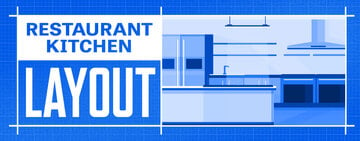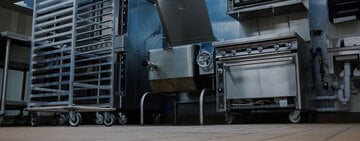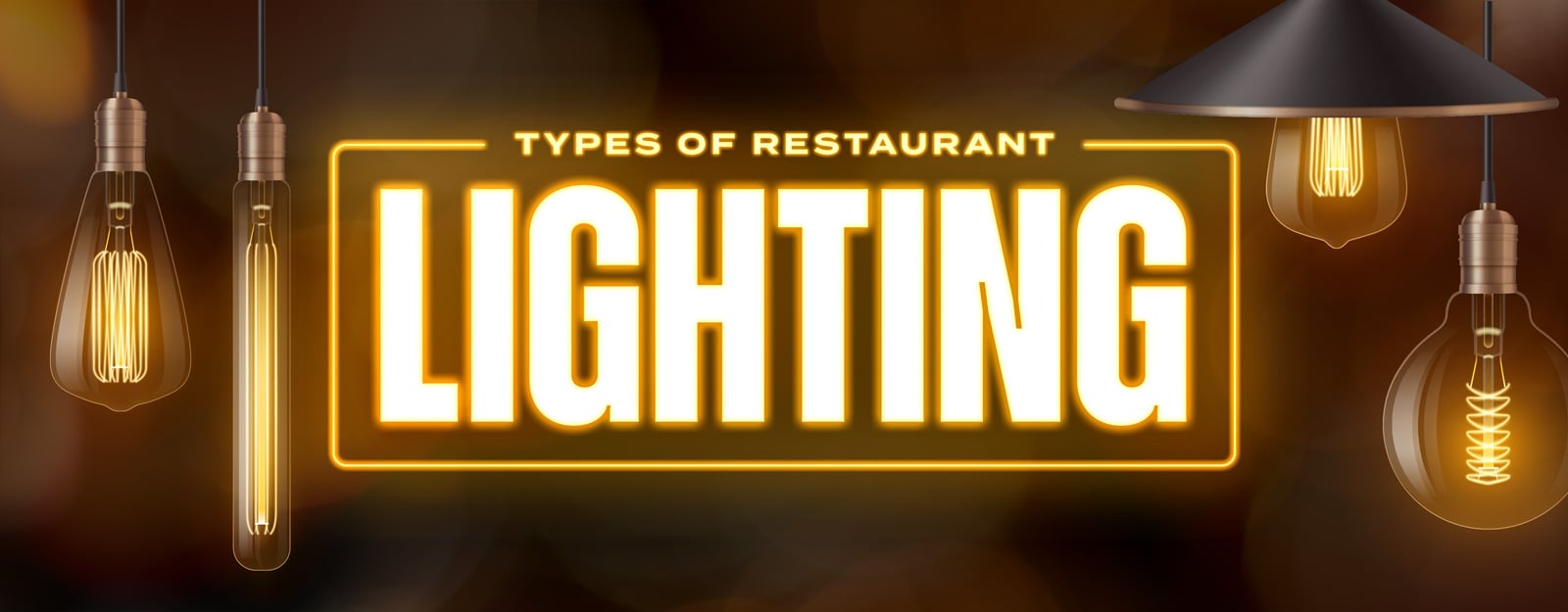
Lighting plays a crucial role in the success of any restaurant. It not only creates a welcoming and comfortable atmosphere for customers but also enhances the overall dining experience. The right lighting can make food and beverages appear more appetizing, highlight the restaurant's unique features and designs, and set the desired mood. Discover below the most important aspects operators need to consider when deciding restaurant lighting, and how they can utilize it to affect the moods and experiences patrons have at their restaurant.
Shop All Restaurant LightingRestaurant Lighting Ideas
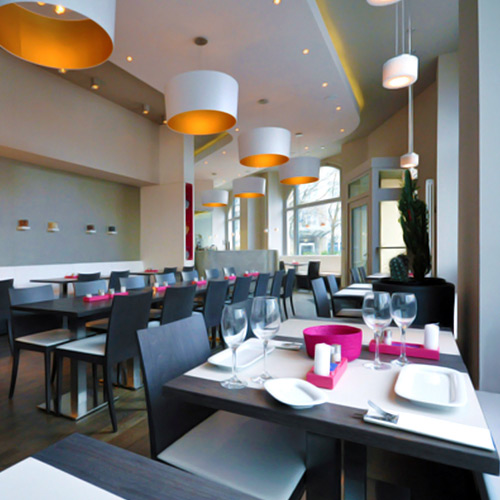
There are four main kinds of lighting: ambient, task, accent, and table. Each type serves a different purpose and can be achieved through different lighting pieces. Below, we describe each type and explain its function.
- Ambient Lighting - Also known as general lighting, this type of lighting is the main source of light in a room. It can be natural light or provided with electric overhead fixtures. Ambient lighting allows people to see and move around your establishment easily and comfortably.
- Task Lighting - Task lighting allows your customers and staff members to perform functions that may need a more concentrated light source, like reading a menu or cooking. It can take the form of overhead lamps, bright fluorescent lights in your kitchen, or a small table lamp on your hostess stand.
- Accent Lighting - This type of lighting adds character to your space. It is used to construct focal points around your front-of-house area. This can be done by using light to highlight pieces of artwork or adding decorative island lights over your bartop.
- Table Lighting - Proper lighting at the dining tables is crucial to create a comfortable and intimate dining experience. Pendant lights or chandeliers placed above each table can provide both ambient and task lighting, while fixtures like table lamps ensure that customers can comfortably read menus and engage in conversations without straining their eyes.
Sometimes light fixtures fit into more than one category of lighting. For instance, placing lanterns on an outdoor patio could be considered accent lighting during the day but ambient lighting at night, when there is less natural light.
Restaurant Lighting Design
Different lighting levels can be used in order to set the mood of your restaurant or bar. This means that customers can either be drawn into your establishment or put off by it simply because of your lighting choices.
Low Lighting
Low lighting can be relaxed and romantic, and it encourages customers to stay longer. Think of a candlelit dinner at a formal restaurant. These settings typically have overhead fixtures with dimmers and lots of accent lighting. The low lighting creates more intimacy, as sections of brighter light, like those over dining tables or your bar area, allow customers to feel like they are more isolated from the other guests in the room.
Note that it is important, even in environments with low lighting, to include enough ambient lighting to perform basic tasks easily and safely.
Bright Lighting
Bright lights provide more stimulation than low lighting. This means that your customers will be awake and alert. Bright lighting is good for high-energy establishments like smoothie shops, cafes, or family-friendly restaurants. This lighting can be achieved with large windows that let in natural light or bright overhead light fixtures.
Lighting for Different Times of Day
When deciding how to light your establishment, keep in mind what type of mood you want your lighting to create throughout the day. What are your restaurant’s hours of operation? If you run a diner or pancake house and generate most of your sales during the morning rush, you won’t be using the same type of lighting that a romantic fine dining restaurant would. And if you run a business that’s open for multiple meals, it could be worth it to adjust your lighting for your brunch, lunch, dinner, or other meal services.
- Breakfast - Bright lighting should be used for meal services earlier in the day. In the morning, customers need bright light to wake up and read their newspapers as they enjoy their coffee. Natural light is the ideal source for this.
- Lunch - Lunchtime services should have moderate lighting. Higher lighting levels are especially good for fast food restaurants and convenience stores, where people won’t be sitting down to eat, but they are grabbing something quickly instead. Lighting can even help create faster turnover rates and flow customers in and out more quickly, so keep this in mind if you'd like your busiest meal service to move faster.
- Dinner - Establishments that do most of their sales during dinner services typically try to have a more relaxing atmosphere, regardless of whether it’s a casual or upscale restaurant. Dinnertime is the most popular time to go out to eat, since customers can sit back and relax after their day. When you provide them with a relaxing atmosphere, your guests may linger and spend more on food, drinks, and dessert, giving you a higher profit.
Types of Restaurant Lighting
There are multiple types of lighting to choose from when setting up your restaurant. You might also need to light the various areas of your establishment differently to account for time of day and preexisting light.
Lighting Fixtures
Electric light fixtures are the easiest types of lighting to control. They are used in every establishment, and they can include overhead fluorescent lights, recessed lighting, tabletop lighting, candles, and any other lighting that you can control and adapt for your business.
Natural Lighting
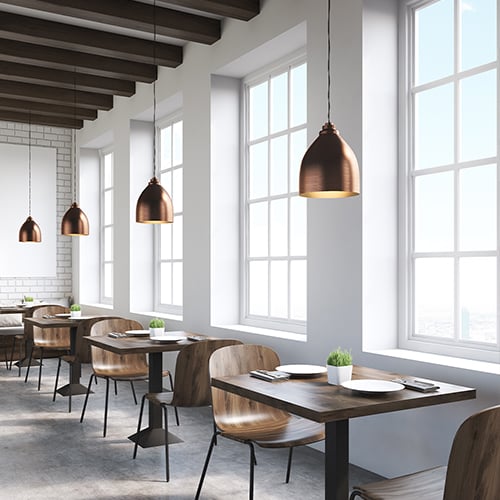
Natural lighting is not only a bright way to light up your establishment--it’s also free! Use this to your benefit by taking advantage of tall windows, doors with large glass panels, and skylights, if you’re able to. Situate seating areas and tables around the perimeter of your restaurant by windows, but be mindful not to place customers directly beside doors, as they might not be comfortable with cold breezes or heavy foot traffic.
To best use natural light, you need to understand the natural light patterns that your restaurant experiences throughout the day due to the movement of the sun. Patrons who are seated facing towards the east or west will be affected the most by direct sunlight, so make sure to install curtains or blinds on your windows to help keep the sun out of their eyes. You should also consider the seasons and the weather, which are other factors that will affect the natural light shining into your restaurant.
Outdoor Lighting
The outside of your restaurant should act as an extension of your dining experience by serving as an advertisement and attraction. Pay as much attention to outdoor lighting as you do indoors by highlighting the architecture of the building, illuminating signage, and brightening eating areas for when natural light is low. String lights and lanterns onto trellises, light fire pits, place candles on top of tables, and create paths back into the entrance of your establishment using outdoor lighting fixtures and techniques.
Safety and security should also be taken into consideration when designing the lighting for your outdoor patio and deck. Parking lots, entrances, exits, sidewalks, and ramps should all be well lit to prevent accidents. Place spotlights on outdoor signs so people can find your business, and see that you’re open. Outdoor lighting also helps to diminish the chance of vandalism and break-ins from intruders and is a key aspect of outdoor pest control.
Smart Restaurant Lighting
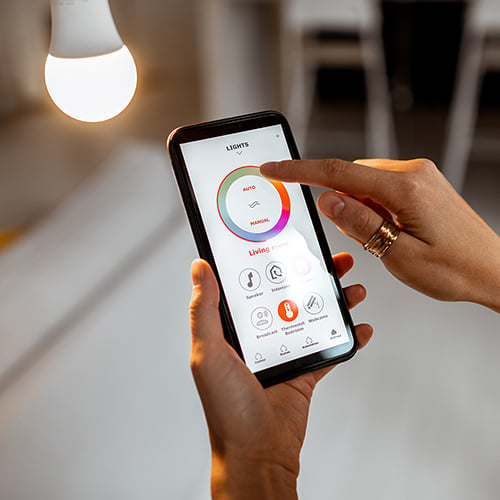
In today's fast-paced restaurant industry, efficiency and cost savings are top priorities for business owners and managers. One way to achieve these goals is by utilizing smart restaurant technology. Smart lighting systems offer a range of features and benefits that can enhance the dining experience, improve energy efficiency, and reduce operational costs. Below we've listed some of the most popular smart lighting systems restaurants utilize and how they can benefit your establishment:
- Daylight Sensors - By integrating with the existing lighting infrastructure, daylight sensors can automatically dim or turn off lights when sufficient natural light is available. This not only reduces energy usage but also creates a more comfortable and natural ambiance for diners.
- Dimming Control - Smart lighting systems offer precise dimming control, allowing restaurant owners and operators to create the perfect lighting atmosphere for different occasions. Whether it's a bright and vibrant setting during peak hours or a more intimate and cozy ambiance for evening dining, dimming control enables easy adjustment of light levels to suit the desired mood.
- Occupancy Sensors - These sensors detect the presence or absence of people in a designated area and adjust the lighting accordingly. By automatically turning off lights in unoccupied spaces or activating them when someone enters, occupancy sensors help to conserve energy and optimize lighting usage.
- Timelocks - With timelocks, lights can be set to turn on or off at predetermined times, ensuring that the restaurant is well-lit during operating hours and conserving energy during non-operational periods. Timelocks provide both convenience and energy savings, allowing business owners to automate lighting control and focus on other aspects of running their establishment.
Restaurant Lighting Fixtures
When choosing the right lighting fixtures for your restaurant, it is crucial to create a visually appealing and comfortable dining experience. Consider the types of fixtures, their positives, and how they can solve your space's design and functionality needs. By carefully selecting and placing the right lighting fixtures, you can enhance the ambiance and atmosphere of your restaurant, leaving a lasting impression on your customers.
1. Restaurant Pendant Lights
Pendant lights are a popular choice for many restaurants due to their versatility and stylish designs. These fixtures hang from the ceiling and provide focused lighting over specific areas such as dining tables or bar counters. Pendant lights come in various shapes, sizes, and materials, allowing you to choose the perfect fixture that complements your restaurant's interior design.
2. Restaurant Chandeliers
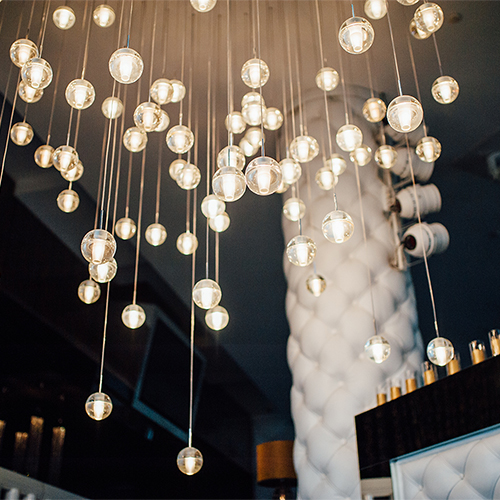
These grand fixtures are typically suspended from the ceiling and feature multiple arms adorned with decorative elements such as crystals or glass shades. Chandeliers are a classic and elegant lighting option that can instantly elevate the ambiance of your restaurant. By choosing the right chandelier, you can create a sophisticated and luxurious atmosphere that leaves a lasting impression on your guests.
3. Restaurant Ceiling Fans
For restaurants located in warmer climates or outdoor dining areas, ceiling fans are a practical and energy-efficient lighting solution. These fixtures combine the functionality of a fan with integrated lighting, providing both air circulation and illumination. Ceiling fans also help keep your customers comfortable and add a decorative element to the space.
4. Commercial Sconces
Sconces are wall-mounted lighting fixtures that can add a touch of elegance and warmth to your restaurant. These fixtures are commonly used in hallways, entryways, or as accent lighting to highlight artwork or architectural features.
5. Restaurant Track Lighting
This type of lighting fixture consists of a track mounted on the ceiling or wall, with adjustable light heads that can be positioned to highlight specific areas or objects. Track lighting is commonly used in restaurants to illuminate dining tables, buffet stations, or retail displays.
6. Restaurant LED Lighting
LED lighting has become increasingly popular in the restaurant industry due to its energy efficiency, long lifespan, and versatility. For instance, warm white LEDs can create a cozy and intimate dining experience, while cool white LEDs can give a modern and vibrant feel to the space.
7. Restaurant Recessed Lighting
Since they're installed directly into the ceiling, recessed lighting creates a sleek and unobtrusive lighting solution for restaurants. These lights provide a dispersed and even illumination, making them ideal for general lighting in dining areas or hallways.
8. Restaurant Kitchen Lighting
In a restaurant kitchen, proper lighting is essential for ensuring a safe and efficient work environment. Task lighting, such as under-cabinet lights helps chefs and kitchen staff see clearly while working.
Back to TopLighting is an extremely important part of restaurant design. From the different types of lighting and the proper use of natural light to the latest restaurant technology in smart lighting, there’s a lot to take into account. So whether you’re trying to set the right mood in your new bar or you need to adjust your restaurant between your lunch and dinner services, lighting can make all the difference.



